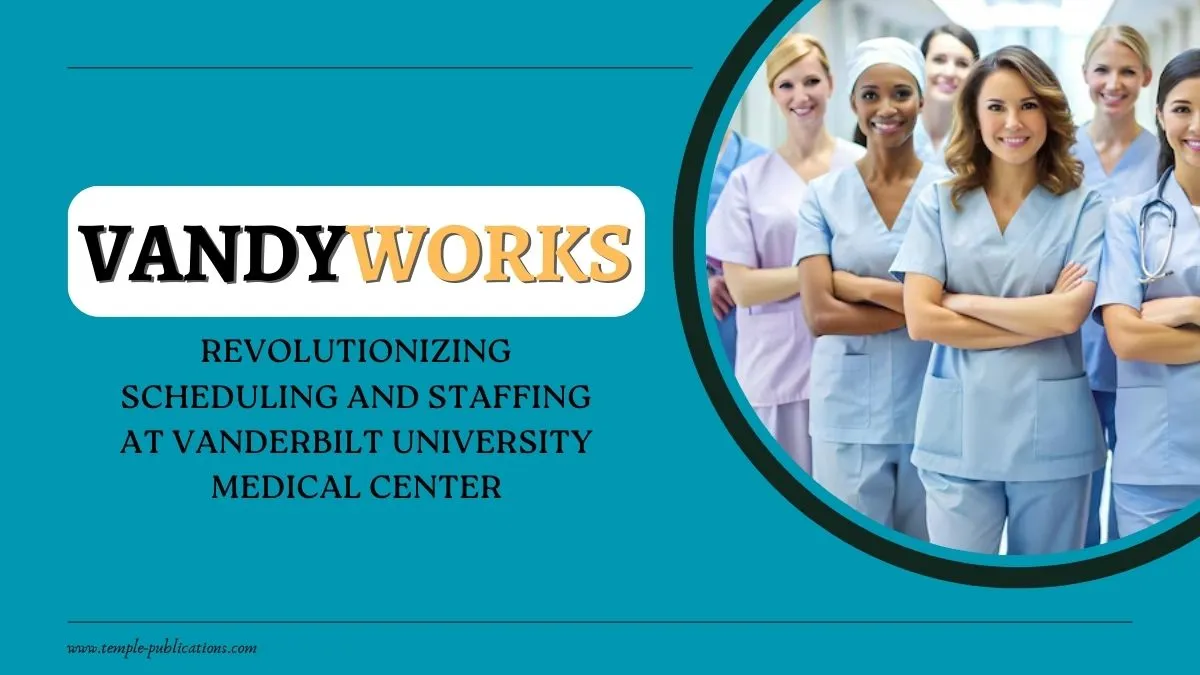GENERAL
VandyWorks: Revolutionizing Scheduling and Staffing at Vanderbilt University Medical Center

VandyWorks is a web-based scheduling and staffing system that has been instrumental to VUMC with more than 19000 employees that the medical center has on its payroll. As a Workbrain application developed by the Canadian company VandyWorks, Innovative features complex to solve everyday problems inherent to arrival shift scheduling in the health care industry, including potential problems with nursing fatigue or workplace mistakes and policy compliance.
Key Features and Capabilities of VandyWorks
Intuitive Interface
Also, simplicity is a clear strength for VandyWorks, as it seems simple to operate for anyone. The idea of user-friendly is integrated into the system with the intention that even subordinates can easily understand and operate it. The interface is very tidy and uncluttered, which is good because the navigation system is not complex and lets users reach the scheduling tools, reports, and communication options.
Robust Reporting Capabilities
Through different types of reports, VandyWorks provides tools to administrators or managers for better decision-making. For instance, it creates different types of reports such as shift coverage, employee schedules, and compliance with certain policies. Sophisticated reporting tools allow users to modify a report according to their requirements, which can help in decision-making processes.
Advanced Communication Tools
Effective communication is crucial in a healthcare setting, and VandyWorks excels in this area. The system includes advanced communication tools such as in-system messaging and notifications. These features facilitate real-time updates and seamless communication between team members, reducing misunderstandings and ensuring that everyone is aligned.
Seamless Coordination
Coordination among departments is essential for operational efficiency and patient care. This integrated approach enhances coordination by providing tools to manage team schedules and shifts across various departments. It ensures that all departments work harmoniously, optimizing resource allocation and minimizing scheduling conflicts.

Automated Scheduling
One key advantage is that the function allows for automating the scheduling process of the work. The systems help in the generation, organization, and maintenance of the schedules, thus sparing staff most of the time and preventing mistakes. Another is that users can adjust the parameters of schedules according to the demands of the particular department and guarantee that shifts will be well-distributed at the company.
Reduced Administrative Time
By automating scheduling processes and providing robust reporting tools, VandyWorks significantly reduces administrative time. This efficiency allows staff to focus more on patient care and less on manual scheduling tasks, leading to improved overall productivity.
Compliance with the Scheduling Policy
Compliance with institutional scheduling policies is a critical aspect. The system is designed to adhere to VUMC’s scheduling policies, ensuring that all shifts and staffing decisions meet regulatory and organizational standards. This feature helps maintain consistency and fairness in scheduling practices.
Integration with Medical Center Systems
VandyWorks seamlessly integrates with other systems used within the medical center, promoting interoperability and data consistency. This integration ensures that information flows smoothly between different systems, enhancing overall operational efficiency and supporting accurate data analysis.
Benefits for Employees of VandyWorks
Support for Nursing Fatigue
Another critically important area of nursing is nursing fatigue, and VandyWorks considers this issue. To minimize the risks of overworking the personnel and guarantee enough rest for the nurses, the system has applied scheduling features. Thus, besides organizing shift work and scheduling techniques, VandyWorks helps to support healthy and productive nurses.
Reduction of Workplace Errors
The consequences of scheduling discrepancies are not minor particularly when practicing in a healthcare facility. VandyWorks minimizes the possibility of such mistakes through some of the features incorporated in the software such as automated scheduling and reporting. Reducing the need for manual inputs and giving complete transparency of what is happening within the scheduling system eradicate any chances of human error.
Streamlined Communication between Team Members
One of the key ways through which people in the workplace relate is through communication; thus good communication in an organization is critical for teamwork. This reduces the barriers to communication by providing gadgets that enable real-time messages and notifications as provided by VandyWorks. Such uncrowded communication helps members of the team to be informed and enables them to work in one way or the other.

Ease of Implementation
Choosing a new scheduling system can be quite a difficult process but the new scheduling system is not very hard to implement. Due to the user-friendly nature of the system and all-around support available to render users comfortable, there will be very little disruption to the ongoing operations, hence the smooth transition of the system.
Accessibility from Any Device
VandyWorks is an online-based system, and one is not required to download and install the application because it can be accessed through any system that has an internet connection. Such flexibility enables the employee to exercise some control over the schedules, the reports, the communication, and the collaboration mainly with other employees irrespective of location making it strong support of the organizational remote work and the constant access to the important information.
Impact on Patient Care
Cross-departmental collaboration is essential for delivering high-quality patient care. VandyWorks fosters this collaboration by providing tools that coordinate schedules and streamline communication across departments. This integrated approach enhances teamwork and ensures that patient care processes are well-coordinated.
Enhancing Patient Care Outcomes
The precision offered by VandyWorks boosts patient care since clients receive efficient solutions that fully suit their needs without compromise. With more efficient scheduling and less paperwork, the system frees up time for HCPCs to spend more time with patients, which is good for both patients and HCPCs.
Future Developments
VandyWorks is continuously evolving to meet the changing needs of healthcare organizations. Upcoming features and enhancements are planned to further improve scheduling efficiency, communication, and integration. Staying abreast of these developments will help users maximize the system’s potential.
-

 BIOGRAPHY6 months ago
BIOGRAPHY6 months agoBehind the Scenes with Sandra Orlow: An Exclusive Interview
-

 HOME1 year ago
HOME1 year agoDiscovering Insights: A Deep Dive into the //vital-mag.net blog
-

 HOME1 year ago
HOME1 year agoSifangds in Action: Real-Life Applications and Success Stories
-

 BIOGRAPHY1 year ago
BIOGRAPHY1 year agoThe Woman Behind the Comedian: Meet Andrew Santino Wife




























